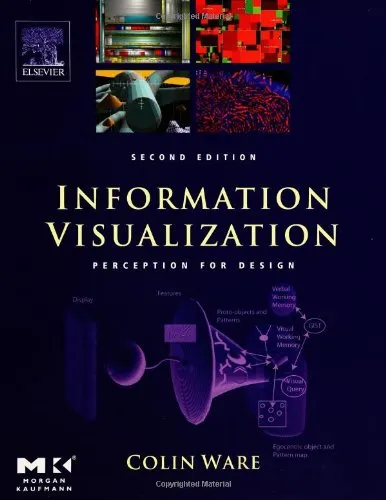Information Visualization: Perception for Design, 2nd Edition
4.5
Reviews from our users

You Can Ask your questions from this book's AI after Login
Each download or ask from book AI costs 2 points. To earn more free points, please visit the Points Guide Page and complete some valuable actions.Introduction to "Information Visualization: Perception for Design, 2nd Edition"
"Information Visualization: Perception for Design, 2nd Edition" by Colin Ware is a seminal work in the field of data visualization and visual communication. This book is an essential guide for anyone interested in understanding the science behind effective visual design, particularly how human perception interacts with visualized data. Building on the knowledge of perceptual psychology, cognitive science, and graphic design, this second edition brings fresh insights, updated research, and improved techniques to convey information clearly and effectively.
The goal of the book is to help readers design visualizations that not only look aesthetically pleasing but also facilitate efficient communication of complex data. It draws upon foundational research in human perception to illuminate how visualization plays a crucial role in aiding decision-making, uncovering patterns, and enhancing comprehension. Whether you are an interaction designer, a data scientist, or a student delving into the world of data communication, this book will prove to be a transformative resource that bridges the gap between theory and practical design applications.
Detailed Summary of the Book
The book begins by introducing the concept of visualization as a cognitive tool designed to amplify human intelligence. It explores the fundamental principles of how we perceive patterns, motion, and color, immersing the reader in the mechanics of vision. Chapters delve deeply into specific perceptual phenomena such as pre-attentive processing, spatial cognition, and color theory, each essential for creating effective data visualizations.
Ware offers practical, science-based guidance on topics like designing graphs, charts, and maps, focusing on how these visual representations align with our sensory and cognitive abilities. He presents various scenarios where intuitive design principles can help viewers interpret data faster and more accurately. The second edition also includes discussions about motion, interactions, and data visualization in digital interfaces, making it highly relevant for today’s rapidly advancing technological landscape.
By combining empirical research with hands-on techniques, the book walks the reader through a wide range of applications, from simple bar charts to complex multidimensional data visualization. It is written with both the seasoned designer and the novice reader in mind, providing clear explanations alongside actionable recommendations.
Key Takeaways
- Understanding the core principles of perception that influence how we interpret visual information.
- Utilizing color, shapes, and motion effectively in designing visualizations.
- Leveraging pre-attentive processing to direct attention to key aspects of a visualization.
- Combining design techniques with insights from cognitive psychology to create intuitive visual communication tools.
- Addressing challenges posed by real-world data and finding ways to communicate complexity without overwhelming the user.
Famous Quotes from the Book
“The purpose of visualization is insight, not pictures.”
“For a designer of visualization, the challenge is to present large datasets in a way that our limited visual processing ability can handle efficiently.”
“Seeing is a cognitive act. What we see is determined not just by what we look at, but also by how we interpret what we see.”
Why This Book Matters
In the modern world, we are inundated with data, which makes the ability to visually interpret and communicate information critically important. "Information Visualization: Perception for Design, 2nd Edition" stands out because it not only teaches readers how to create visualizations but also explains why certain approaches work. By grounding its techniques in the principles of human perception and cognition, this book equips designers and developers to create tools that are intuitive, effective, and meaningful.
This book matters because it bridges the gap between technical expertise and human-centered design. It encourages readers to think beyond aesthetic considerations and focus on producing visualizations that serve a purpose. Whether used in academia, business, or industry, the insights provided in this book empower professionals to harness the power of visualization to drive understanding and innovation.
With its blend of science and art, "Information Visualization: Perception for Design" remains a cornerstone in the study and practice of data visualization. Its relevance in tackling today’s data-driven challenges while adhering to timeless principles of perception makes it a must-read for anyone in the field.
Free Direct Download
You Can Download this book after Login
Accessing books through legal platforms and public libraries not only supports the rights of authors and publishers but also contributes to the sustainability of reading culture. Before downloading, please take a moment to consider these options.
Find this book on other platforms:
WorldCat helps you find books in libraries worldwide.
See ratings, reviews, and discussions on Goodreads.
Find and buy rare or used books on AbeBooks.
1145
بازدید4.5
امتیاز50
نظر98%
رضایتReviews:
4.5
Based on 0 users review
"کیفیت چاپ عالی بود، خیلی راضیام"
Questions & Answers
Ask questions about this book or help others by answering
No questions yet. Be the first to ask!


